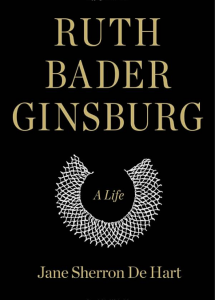Book review: “Ruth Bader Ginsburg”: The evolution of a justice

on Jan 11, 2019 at 10:04 am

One might think that the market for treatments of the life and legacy of Justice Ruth Bader Ginsburg would be saturated by now. The past three years alone have seen the release of a carefully curated collection of the justice’s writings, “My Own Words,” a surprise hit documentary about her life and career, “RBG,” and a recent feature film, “On the Basis of Sex,” which focuses on the first sex-discrimination case Ginsburg argued in federal court. Now comes “Ruth Bader Ginsburg: A Life,” by Jane Sherron De Hart, a retired professor of history at the University of California, Santa Barbara. This book began as a research project examining Ginsburg’s early career as a women’s-rights litigator at the American Civil Liberties Union, and it expanded into a full-length biography (540 pages of text and 110 pages of footnotes).
Ginsburg spoke at length to the author during the early, limited part of the project, but she curtailed her cooperation later, likely because an authorized biography was (and remains) in the works. Whether because of De Hart’s own initial interest or the benefits of consultation with Ginsburg, the book is strongest when it focuses on Ginsburg’s early life and her work before her appointment to the U.S. Court of Appeals for the District of Columbia Circuit in 1980. Readers will meet straight-A student and Brooklyn baton-twirler “Kiki” Bader, whose mother Celia died of cancer two days before Kiki’s high-school graduation. They will shake their heads at the notion that Ginsburg, although graduating at the top of her class from Columbia Law School, was offered a clerkship with a federal judge only after her law professor Gerald Gunther offered to substitute another (presumably male) candidate if Ginsburg did not pan out. And they will be touched by Ginsburg’s enduring partnership with her husband, Marty, who, as Ginsburg has said, “believed in me more than I believed in myself.”
Some of De Hart’s most valuable insights come in her account of how Ginsburg, who, in an effort “not [to] be considered confrontational,” responded to Harvard Law School Dean Erwin Griswold’s query about why she was occupying a place in the first-year class that could have gone to a man by saying it was important for her to “understand her husband’s work,” came to espouse women’s rights so whole-heartedly. De Hart traces some through lines that help explain how Ginsburg developed the ideas of equality that informed her determination to secure equal treatment for women under the law. Notable among these was a fortuitous sojourn in Sweden to research Swedish civil procedure. Ginsburg was struck by “the greater gender equality Swedes enjoyed” and by Swedish theorists’ and social scientists’ contention that “culturally constructed roles – stereotypical assumptions about the proper role of men and women – imposed constraints on both sexes that penalized individuals and impoverished society.”
Ginsburg’s experiences in Sweden, coupled with the sexism she had experienced and the influence of feminist writers like Simone de Beauvoir, prompted her to helm the ACLU’s new Women’s Rights Project. Her analytical tenacity, single-minded focus on work, meticulous planning, and uncompromisingly high standards enabled her to devise and carry out her goals successfully. De Hart offers detailed accounts of the series of cases through which Ginsburg succeeded in persuading the Supreme Court to raise the standard of review for laws that treated men and women differently based on damaging stereotypes about gender roles. She observes, as have others before her, that Ginsburg’s incremental approach – building in small steps on early cases with sympathetic plaintiffs, often men – was modeled on Justice Thurgood Marshall’s strategy of combating racial discrimination as a litigator for the NAACP. But she also highlights the pitfalls of equating gender discrimination with racial discrimination, particularly as an increasingly conservative Supreme Court began to insist on a “color blind” approach to the Constitution that subjected affirmative action programs to strict scrutiny.
Readers familiar with the pop-culture trope of Ginsburg as a fearless champion of liberal ideals may be surprised by De Hart’s reminder that the justice’s nomination was almost forestalled by her criticism of Roe v. Wade, which she publicly suggested may have done abortion rights a disservice by, among other things, leapfrogging legislative change and prompting a powerful political backlash. De Hart exposes the rifts within the feminist movement that led President Bill Clinton to respond, when Ginsburg’s name was first floated, that “the women are against her.”
De Hart’s account of Ginsburg’s years on the Supreme Court, though detailed and methodical, is less compelling, perhaps because De Hart had to rely on oral argument transcripts and opinions instead of interviews and the contemporaneous documents of the justices, most of which are not publicly available. Also evident in this section of the book is De Hart’s unhappiness with the conservative bent of the current Supreme Court. Although this ideological stance is not surprising given the clear respect for Ginsburg’s work that led De Hart to write this book, the author’s stridency sometimes detracts from her analysis.
These criticisms aside, De Hart offers the reader a comprehensive tour of Ginsburg’s Supreme Court career. She catalogs the justice’s occasional victories, like United States v. Virginia, in which Ginsburg wrote a majority opinion striking down the Virginia Military Institute’s male-only admission policy, and her more frequent setbacks. Those setbacks spurred Ginsburg to write the strong dissents that inspired her pop-culture persona, the “Notorious RBG.” Court-watchers humorously compared her scathing critique of the conservative majority’s decision in a landmark voting-rights case to Biggie Smalls’ biting rap lyrics. The rest is history – and shelves full of RBG merchandise.
A central question in the book is how a tiny, soft-spoken civil-procedure maven memorably described by Justice Harry Blackmun after an oral argument as a “very precise female” became a progressive icon. To some degree, this apparent contradiction simply reflects the differing facets of the justice’s personality: She is a detail-oriented workaholic who is moved to tears by grand opera, an ambitious achiever who delights in friends and family, and a rule-follower willing to rewrite the rules to correct injustice. In another sense, Ginsburg’s perceived evolution from “a woman for whom the word ‘moderate’ dangled from her wrist like an ID bracelet” to the inspiration for a Kickstarter-funded action figure is a function of the increasing conservatism of the Supreme Court. Yesterday’s New Deal moderate is today’s left-wing dissenter. In the immortal words of Norma Desmond in “Sunset Boulevard” – whom Ginsburg otherwise resembles only in her fondness for wearing turbans – “I am big. It’s the pictures that got small.”
The author of this book review clerked for Ginsburg from 1989-1990 on the U.S. Court of Appeals for the District of Columbia Circuit and testified before the Senate Judiciary Committee in support of Ginsburg’s nomination to the Supreme Court in 1993.



